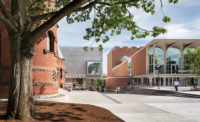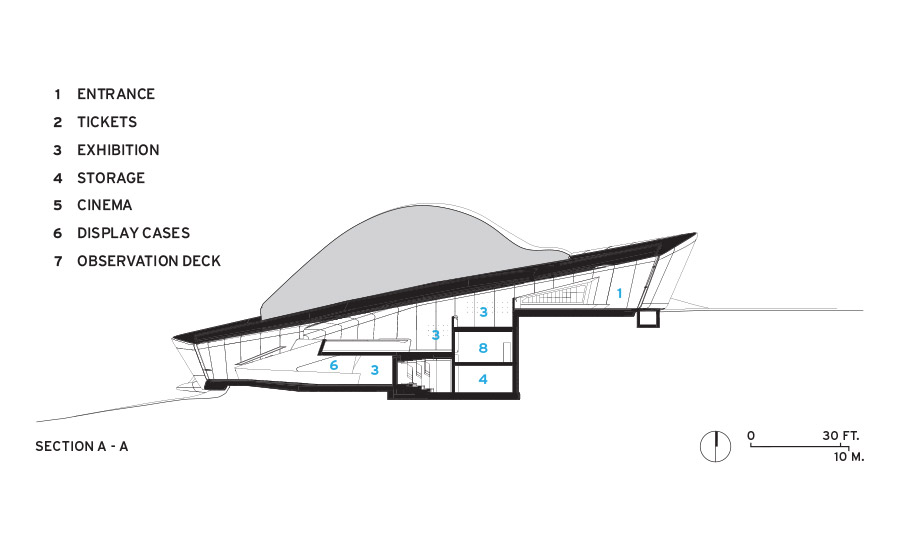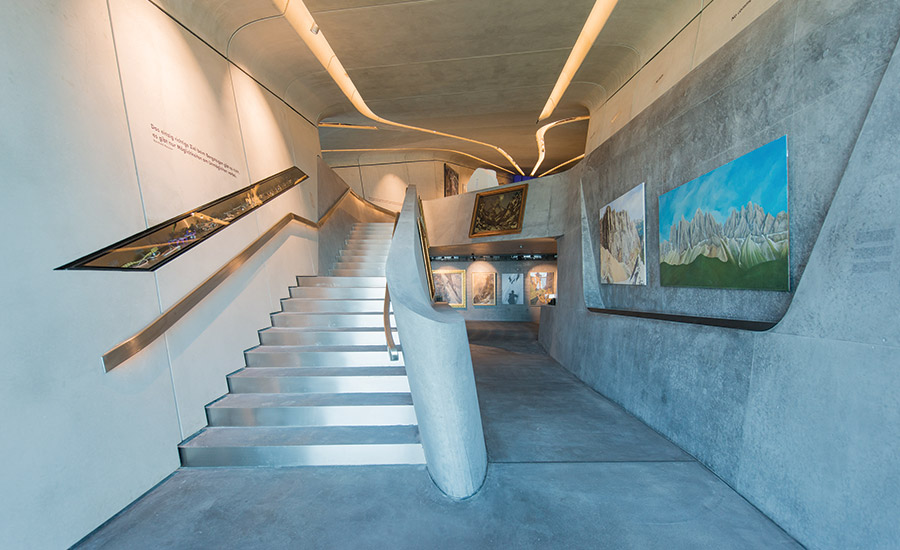Messner Mountain Museum Corones
A mountaineering museum puts the daunting and spectacular landscape around it into sharp focus.

Zaha Hadid’s Messner museum, on top of Kronplatz Mountain in northern Italy, looks down to the Val Badia below. The winding path takes visitors from cable cars to the entrance.
Photo © Harald Wisthaler

Image courtesy Zaha Hadid Architects

Image courtesy Zaha Hadid Architects

The entrance portal, pictured here, and an ancillary bay next to it face northeast toward a slightly rocky but level terrain.
Photo © Hufton + Crow

On the opposite side, three hooded projections jut out from the earthy mound in different directions.
Photo © Hufton + Crow

The poured-in-place concrete structure, clad in glass-fiber-reinforced concrete panels, bends to frame the panoramic views, especially dramatic in the cantilevered observation deck.
Photo © Hufton + Crow

Stairs from the top entrance level lead down past paintings and paraphernalia related to mountain climbing.
PHOTO © Hufton + Crow

Each of the projecting windows is angled in a different direction, including one facing south
Photo © Harald Wisthaler

A large cantilevered terrace extends dramatically from its curved hood.
PHOTO © Harald Wisthaler

Image courtesy Zaha Hadid Architects

Image courtesy Zaha Hadid Architects











Architects & Firms
Bolzano, Italy
Designing a museum is nothing new for Zaha Hadid Architects. Creating one on top of Mount Kronplatz in northern Italy is something else entirely. The 10,800-square-foot structure, which opened in July, is 7,464 feet above sea level. It is the sixth edition in the Messner Mountain Museum (MMM) network. Initiated in 1995 by the fabled 71-year-old Reinhold Messner, a South Tyrolean who has climbed 14 mountains over 8,000 meters (26,247 feet) high, the six exhibition spaces explore different aspects of the history of mountaineering in general, with some attention to the local geography. While Messner located most of his museums in old castles and forts, he buried one totally underground in a slope halfway up the 12,811-foot-high Ortler peak. This latest museum, on Kronplatz—his final one—is not only higher, but very different. Called the Messner Mountain Museum Corones, its contoured forms project energetically from an earth-covered mound to offer staggering, vertiginous views of the surrounding mountains.
Zaha Hadid’s involvement in the sky-high museum began when she won an invited competition to design a peak-top observation deck for Skirama Kronplatz/Plan de Corones, a consortium of cable-car and ski-lift operators, to boost tourism after the ski season ends. When Messner approached Skirama with his idea for a museum on Kronplatz, the company head, Andrea del Frari, suggested Hadid do it. The choice of Hadid was not a stretch: she had designed the Bergisel Ski Jump at Innsbruck in 2002, and four Nordpark Cable Railway stations there in 2007. While Messner, who studied civil engineering, was not deeply familiar with her work, the architects in her firm found him to be open to Hadid’s biomorphic interpretation of his program. Intensely involved in the design process, he wanted the museum to be partially subterranean. “We really liked Messner’s idea of reducing the building’s impact on the alpine site by putting it underground,“ says Peter Irmscher, a member of Hadid’s team, about the sculptural, poured-in-place concrete structure burrowed within nature. And the observation deck that Skirama initially wanted was incorporated into the scheme. While Del Frari makes light of building at that altitude—“We are used to this. We don’t rely on helicopters, just trucks going up the roads,” he says—Irmscher points out that the sheer height and long months of snow limited construction to the summer. It took three years to build.
After arriving by cable car, you enter the curvilinear concrete portal on the northeast into what looks like a beehive. From the lobby, you descend stairs and ramps to a choice of three pronglike spaces. From the outside, the stubby projectiles look like a trio of giants’ hoods; from the inside, they capture breathtaking views of the Zillertal Alps and the Dolomites.
You do not encounter these vistas upon initially entering the cavelike interior. At first, you see an aluminum ladder mounted near the entrance, used by sherpas to help climbers ascend Mount Everest. (Messner used ladders when he conquered the mountain in 1978, but he did forgo supplemental oxygen.) As you descend the levels toward the source of daylight, you find the first window looks toward farmers’ houses in the valley below as well as the massive wall of Heiligkreuzkofel mountain, which Messner considers his most difficult climb. A second, lower level allows you to see the Peitlerkofel, the peak enclosing the valley where Messner was born and raised. Finally, on the lowest level, you step out on the observation deck, jutting out toward Ortler, the highest peak of the eastern Alps. The breathtaking panorama is 270 degrees.
On display within the curvilinear, fluid spaces are paintings of mountains from Messner’s private collection, including an evocative contemporary oil of Mount Everest by Jürgen Stäudtner and Grosse Karte des Alpinismus (the Grand Map of Alpinism) by Stephan Huber, who worked with Messner on creating this artwork of maps, photos, and text related to scaling peaks around the world. Also on display are such historic tools used in climbing as a hammer belonging to Paul Preuss, the Austrian alpinist, and other related artifacts.
It’s understandable if the visitor is torn between enjoying the extraordinary views outside and studying the works within. Messner’s daughter, Magdalena, coordinator of the six museums, initially worried that the architecture would contrast too starkly with its figurative contents. Today she finds the building remarkable in the way it fits into the landscape.
But father and daughter weren’t the only ones unfamiliar with Hadid’s approach. Skirama’s builders weren’t fluent in the language of Hadid’s boomerang-shaped forms. In this case, the process involved pouring the reinforced concrete as canted planes and then fitting curved precast panels of glass-fiber-reinforced concrete into place on the exterior and interior surfaces, in order to give the volumes the sinuous contours for which Hadid’s work is so well-known. Nevertheless, Irmscher found the construction crew was “passionate and ambitious,” and the workers achieved a high level of execution. The ladder on display at the entrance is an apt symbol for the entire production of this museum, since plenty of mental ladders had to be climbed to end up with this result. Even Messner himself was open to climbing a metaphorical one with this design.
PeopleArchitect: Personnel in architect's firm who should receive special credit: Associate Architect and Structural Engineer: Engineers: Electrical: Studio GM Contractors: Concrete Façade Specialists: Substructure/Assembly: Excavation Works: Screed: Construction Management: Geology: Surveyors: Consultants : M&E Engineers (Ventilation): Weger M&E Engineers (Heating, Sanitary): Termotecnica Kastlunger Electrical Engineers: Studio GM (Planning) Acoustic Consultants: Ie-acoustic Acoustical Ceilings: Moling Alberto Srl Electrician: elpo GmbH Lighting Consultants: Zumtobel Client: Skirama Kronplatz/Plan de Corones Completion date: July 2015 Size: 10,800 square feet Cost: $3.3 million |
ProductsGraber Hermetique Gutters Glazing Balustrades Locksmith Flooring Media Displays Interiors Carpenters: Möbel Mareo KG Interiors: Appenbichler Raumausstattung Lifts/elevators: Kronlift Plasterers: Moling Alberto Srl |















